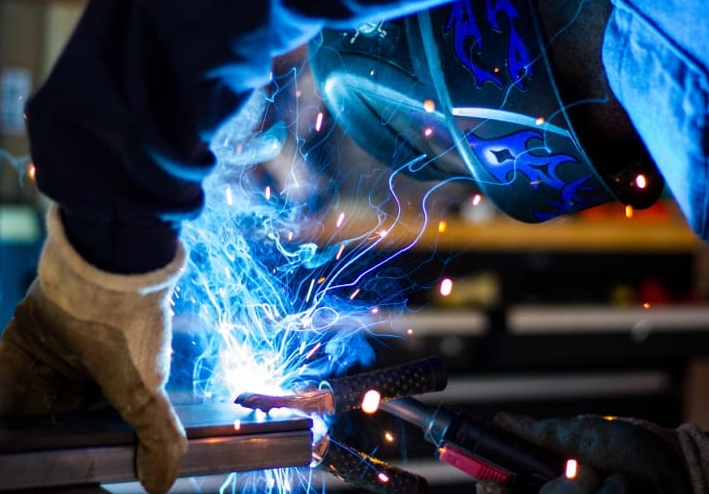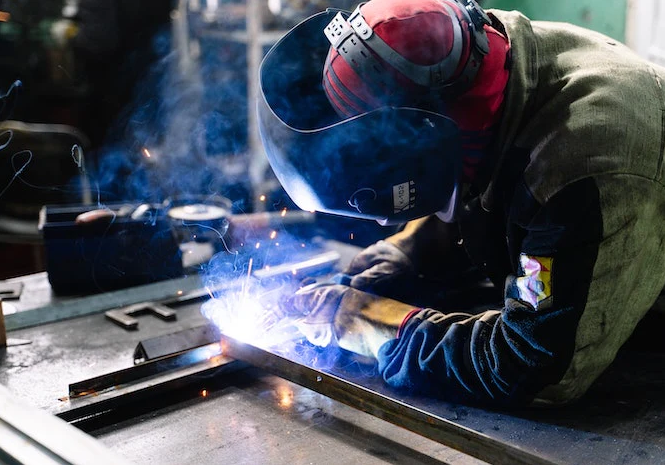Understanding Gasless MIG Welding
The Basics of Gasless MIG Welding
Gasless MIG welding, a form of Metal Inert Gas (MIG) welding, uniquely operates without an external shielding gas. Instead, it uses a self-shielding flux-cored wire, simplifying the setup and reducing costs. The process starts with loading the flux-cored wire into the welder. Then, by creating an electric arc between the wire and the metal, it melts the wire, allowing it to fuse with the base material, forming a strong joint.
This method particularly shines in outdoor conditions, where winds might disrupt the shielding gas in traditional MIG welding. Moreover, it offers greater portability, as there’s no need to carry gas cylinders. However, it’s crucial to ensure the correct power settings and wire feed speed for optimal results. For stainless steel, the power range usually lies between 130 to 160 amps, depending on the thickness of the material.

Advantages of Gasless MIG for Stainless Steel
Gasless MIG welding holds several advantages when working with stainless steel. Firstly, it significantly reduces the overall cost. The absence of gas tanks not only cuts down on material costs but also on storage and transport expenses. In terms of efficiency, gasless MIG welding can operate at a higher speed compared to traditional methods.
Another notable advantage is its versatility. It adapts well to different thicknesses of stainless steel, ranging from thin gauge sheet metal to thicker structural components. The typical thickness range where gasless MIG excels is between 0.8 mm to 4.8 mm. Additionally, this method produces less spatter and offers cleaner welds, which is vital when aesthetics are a concern.
However, it’s important to note that while gasless MIG is effective, it might not always match the weld quality and appearance of gas-shielded methods, especially in ultra-high precision applications. Despite this, for many projects, the speed, cost-effectiveness, and versatility of gasless MIG make it a highly attractive option for welding stainless steel.
Equipment and Materials for Gasless MIG Welding
Selecting the Right Welder for Stainless Steel
Choosing a suitable welder for stainless steel is crucial for successful gasless MIG welding. The ideal welder should have a power output ranging from 130 to 160 amps to effectively handle the thicknesses commonly found in stainless steel projects, typically between 0.8 mm to 4.8 mm. Key features to look for include adjustable power settings and a robust wire feed system, which are essential for managing different welding tasks with precision. Brands like Miller, Lincoln, and Hobart are often favored for their reliability and performance. Prices for a quality gasless MIG welder can range from $400 to $800, depending on the specifications and brand.
Essential Accessories and Safety Gear
In addition to the welder, several accessories and safety gear are essential for effective and safe gasless MIG welding:
- Flux-cored wire: Specifically designed for gasless MIG welding, this wire comes in various diameters. For stainless steel, a wire diameter of 0.8 mm to 1.2 mm is typical. The cost of flux-cored wire is around $15 to $25 per pound.
- Welding helmet: A good-quality auto-darkening welding helmet is crucial for protecting the eyes from harmful rays. Prices range from $70 to $150.
- Gloves and protective clothing: High-temperature resistant gloves and flame-resistant clothing are non-negotiable for safety. A set of quality welding gloves and a jacket can cost between $30 to $100.
- Welding clamps and magnets: These tools aid in holding the stainless steel pieces in place, ensuring precision in welding. A basic set can be purchased for around $20 to $40.
- Wire brush and chipping hammer: These tools, essential for cleaning the weld area, typically cost around $10 to $20 each.
Investing in quality equipment and materials not only enhances the efficiency of the welding process but also ensures the longevity and durability of the welded joints. The right tools also contribute significantly to the safety and comfort of the welder, a factor that should never be compromised.
Preparation Steps for Welding Stainless Steel
Proper preparation is key to ensuring a strong and clean weld on stainless steel. This involves both preparing the material and setting up the welding equipment correctly.
Cleaning and Preparing the Steel Surface
Before starting the welding process, it’s essential to thoroughly clean the stainless steel surface. This step involves removing any contaminants like grease, oil, or dirt, which can be done using a solvent or degreaser. After cleaning, use a stainless steel brush to remove the oxide layer on the surface. It’s crucial to use a brush made specifically for stainless steel to avoid contaminating the surface with foreign materials. A quality stainless steel brush typically costs around $10 to $20.
Setting Up the Welder for Gasless MIG
Setting up the welder correctly is vital for achieving optimal results with gasless MIG welding. First, load the flux-cored wire into the welder. Ensure you’re using the correct wire diameter, generally between 0.8 mm to 1.2 mm for stainless steel. Next, adjust the power settings and wire feed speed. For stainless steel, a power setting within the range of 130 to 160 amps is usually appropriate. The wire feed speed will vary depending on the thickness of the steel and the specific welding task. A slower speed is often better for thinner materials to prevent burning through, while thicker materials may require a faster speed for adequate penetration.
Remember, precision in these preparation steps greatly influences the quality and strength of the weld. Taking time to properly clean the steel and finely tune the welder settings can significantly enhance the welding outcome.
Welding Techniques for Stainless Steel
Welding stainless steel with gasless MIG requires specific techniques to ensure strong, clean welds. The key is to control heat input and maintain a consistent welding speed.
Tips for Effective Gasless MIG Welding
- Control Heat Input: Stainless steel is sensitive to high heat, which can lead to warping or distortion. Use a lower power setting, ideally between 130 to 160 amps, to minimize this risk. This power range is effective for most stainless steel thicknesses, from 0.8 mm to 4.8 mm.
- Maintain a Steady Welding Speed: Move the welding gun at a consistent pace to ensure even heat distribution. A slower speed may be necessary for thinner materials, while thicker materials can handle a faster speed. However, moving too slowly can cause the weld to become too hot, leading to burn-through.
Common Mistakes to Avoid
- Incorrect Wire Selection: Using the wrong diameter or type of flux-cored wire can significantly affect weld quality. For stainless steel, ensure the use of a wire specifically designed for it, usually in diameters of 0.8 mm to 1.2 mm.
- Overlooking Surface Preparation: Failing to properly clean and prepare the stainless steel surface can result in poor weld quality. Always clean the surface thoroughly and use a stainless steel brush to remove any oxide layer.
- Ignoring Welder Settings: Not adjusting the welder to the appropriate settings for stainless steel can cause issues like inadequate penetration or excessive spattering. Pay close attention to the power settings and wire feed speed.
- Inconsistent Welding Technique: An unsteady hand or inconsistent speed can lead to uneven welds. Practice maintaining a consistent speed and distance from the material to achieve a smooth, uniform weld bead.
By following these techniques and avoiding common mistakes, welders can achieve strong, aesthetically pleasing welds on stainless steel using gasless MIG. Remember, practice and attention to detail are key in mastering these techniques.

Post-Welding Practices
After completing the welding process, certain practices are essential to ensure the quality and longevity of the welds on stainless steel.
Inspecting and Testing the Welds
Immediately inspect the welds for any signs of imperfections such as cracks, porosity, or uneven bead profiles. Visual inspection is the first step, followed by more rigorous testing methods if necessary. For critical applications, you might employ non-destructive testing methods like ultrasonic testing or X-ray inspection. These methods help in identifying internal flaws that are not visible to the naked eye. The cost of such testing varies depending on the complexity of the inspection but can range from $100 to several hundred dollars for advanced techniques.
Cleaning and Finishing Techniques
- Remove Slag and Spatter: Use a chipping hammer and a wire brush to remove any slag or spatter from the weld area. This step is crucial for aesthetic reasons and to prepare the surface for any further finishing processes.
- Polishing and Grinding: For projects where appearance is important, use a grinder or polisher to smooth out the weld bead. Be cautious not to grind too deeply, as this can weaken the weld. A good quality grinder can cost around $50 to $150.
- Passivation of Stainless Steel: To restore the corrosion-resistant surface of the stainless steel after welding, passivation is often necessary. This process involves treating the steel with a citric or nitric acid solution, which removes free iron from the surface and helps in the formation of a protective oxide layer. The cost of passivation solutions ranges from $20 to $50 per gallon.
- Applying Protective Coatings: In some cases, applying a protective coating may be necessary to enhance corrosion resistance or for cosmetic reasons. The choice of coating and its cost depend on the specific requirements of the project.
These post-welding practices play a crucial role in ensuring that the welds not only perform well but also meet the aesthetic standards required for stainless steel applications. Proper inspection, cleaning, and finishing greatly extend the life and appearance of the welded structures.
Troubleshooting and Problem Solving
Effective troubleshooting in gasless MIG welding of stainless steel is essential to maintain quality and efficiency.
Common Issues in Gasless MIG Welding of Stainless Steel
- Porosity in Welds: This is a common issue where small holes appear in the weld bead, usually caused by contamination or incorrect welding technique.
- Weld Spatter: Excessive spatter around the weld area often occurs due to high wire feed speed or incorrect power settings.
- Incomplete Penetration: This happens when the weld does not fully penetrate the metal, often due to insufficient heat input or incorrect welding angle.
- Distortion of the Weld Area: Heat from the welding process can cause warping or distortion, especially in thinner stainless steel.
Solutions and Preventative Measures
- Preventing Porosity: Ensure the surface is clean before welding and use the correct welding technique. Regularly maintain the welding equipment to avoid issues related to wire feeding.
- Reducing Weld Spatter: Adjust the power settings and wire feed speed. A lower power setting and appropriate speed can significantly reduce spatter.
- Ensuring Complete Penetration: Use the correct power setting and welding angle. For stainless steel, maintaining a power range between 130 to 160 amps is typically effective for various thicknesses.
- Minimizing Distortion: Implement proper welding techniques, such as tack welding and welding in shorter intervals. Also, controlling the heat input by adjusting the welding speed and power settings can help.
Adopting these solutions and preventative measures can greatly reduce common issues in gasless MIG welding of stainless steel. Regular practice and attention to detail are crucial for mastering these techniques and ensuring high-quality welds.


